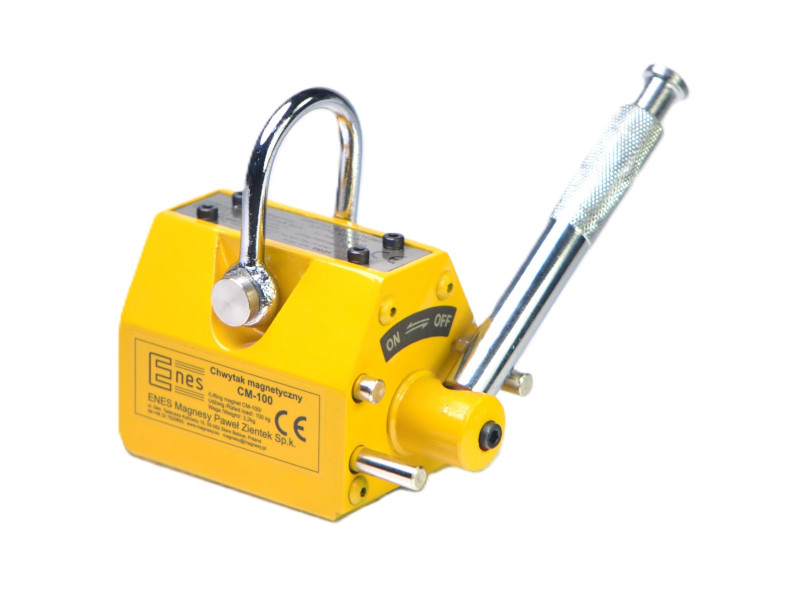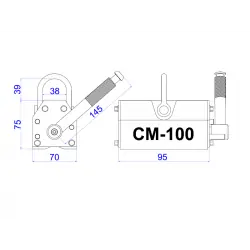








Polityka bezpieczeństwa (edytuj za pomocą modułu „Bezpieczeństwo klienta”)

Zasady dostawy (edytuj za pomocą modułu „Bezpieczeństwo klienta”)

Zasady zwrotu (edytuj za pomocą modułu „Bezpieczeństwo klienta”)
Nominal hoisting capacity: 100 [kg]
Maximum load capacity (breaking load): >350 [kg] - The safety factor for static tests is 3.5 and complies with EN 13155:2021-05
DO NOT LIFT LOADS THAT ARE HEAVIER THAN THE NOMINAL HOISTING CAPACITY !
Lifting magnets are used to lift and move heavy iron and magnetic steel components. These devices do not require any power supply. The magnetic field is switched on and off by adjusting a manual lever. The magnetic field of the lifting magnet is generated by neodymium magnets. They are used in steel yards, factories, warehouses, workshops and docks. They are useful for handling sheet metal, plates, profiles, bars, angles, channels, round and square pipes and other large ferrous workpieces.
Each CM series lifting magnets we attach:
♦ 2 year guarantee
♦ declaration of conformity "CЄ"
♦ capacity measuring protocol
♦ operating instructions
♦ quick reference guide
The actual lifting capacity of each lifters depends on the following factors:
♦ thickness and shape of the workpieces to be lifted (for each lifters the relationship between the lifting capacity and the thickness of the workpieces is given). For cylindrical solid workpieces (cylinders, rods), the lifting capacity is approximately 50% less.
|
Minimum component thickness at which the lifting magnet can be used |
3 mm |
Workpieces that are too thin may be attracted weakly because the magnetic field of the lifting magnets is not fully utilised. In addition, thin workpieces bend and their contact area with the lifters decreases, so that the pulling force decreases. The best lifting performance is obtained for sufficiently thick workpieces.
|
Thickness of the workpiece to be lifted at which the lifting capacity is 100% |
15 mm |
Before starting work, it is important to consider the percentage dependence of the lifting capacity as a function of the thickness of the steel to be lifted (lifting capacity curves can be found in the manual).
When handling round parts such as pipes, rods, steel shafts, the maximum load capacity is reduced:
|
Type |
Shaft diameter |
Max. shaft length |
Max. load capacity |
|
CM100 |
50 [mm] |
100 [mm] |
45 [kg] |
The actual lifting capacity of each lifting magnets also depends on:
♦ the size of the air gap between the lifting magnet surface and the workpiece to be lifted (for each lifting magnets, the capacity characteristics as a function of the size of the non-magnetic gap are given).
|
Nominal load capacity of the CM-100 [kg] |
||||
|
Workpice thickness [mm] |
Non-magnetic gap D between lifting magnet and the workpiece to be lifted |
|||
|
D = 0,0 |
D = 0,1 |
D = 0,3 |
D = 0,5 |
|
|
15 |
100 |
90 |
65 |
48 |
|
10 |
94 |
75 |
57 |
42 |
|
5 |
51 |
42 |
40 |
28 |
|
3 |
22 |
22 |
18 |
18 |
The load capacity depends on the air gap between the lifting magnet surface and the workpiece to be lifted. If the surface roughness of the load Ra is less than 6.3 μm, the capacity of the gripper will not decrease. This is the case for a very clean, flat and sanded surface. If the surface roughness of the materials to be lifted Ra will be greater than 6.3 μm, the gap should be taken into account.
For rusty rolled surfaces, a gap in the range (0.1-0.3 mm) can be assumed, while for rough porous surfaces the gap is estimated in the range (0.3-0.5 mm).
Before starting work, refer to the instructions for the percentage relationship of load capacity as a function of non-magnetic gap.
The actual lifting capacity of each lifting magnets also depends on:
♦ The composition of the load to be lifted (the higher the iron content, the higher the lifting capacity):
|
Type |
Nominal hoisting capacity [kg] |
Load capacity permissible for the material * |
|||
|
Low carbon steel 100% |
High carbon steel 90% |
Low-alloy steel 75% |
Cast iron |
||
|
CM 100 |
100 |
100 |
90 |
75 |
50 |
*) it will be the permissible load for a component made of a given material, if not reduced by other factors (thickness, surface quality, shape).
♦ the ambient temperature and the temperature of the workpiece to be lifted (it must not be higher than 80[oC]).
In lifting magnets, the source of the magnetic field is sintered neodymium magnets, whose maximum operating temperature is 80oC.
We offer:
- consulting,
- service,
- spare parts,
- annual inspections and load capacity tests of lifting magnets, confirmed by a certificate.